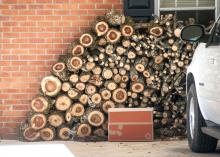Information Possibly Outdated
The information presented on this page was originally released on November 15, 2012. It may not be outdated, but please search our site for more current information. If you plan to quote or reference this information in a publication, please check with the Extension specialist or author before proceeding.
Keep firewood stacks from housing termites
MISSISSIPPI STATE – Many Mississippians own a fireplace for the pleasure and comfort it provides on cold winter nights, but if they’re not careful, the firewood can harbor unwanted guests.
In the winter, the desire to have a handy woodpile can open the door for termite problems. Blake Layton, entomologist with the MSU Extension Service, urged those with fireplaces not to stack wood against the outside wall of the house.
“There is no real risk of termite infestation through wood that is brought inside and burned immediately, but firewood that is stacked against the house, not used and left for the next year creates a high risk of termite infestation,” Layton said.
Andy Londo, an Extension and research professor in Mississippi State University’s Forest and Wildlife Research Center, said incorrectly stored firewood can attract termites, ants and other pests.
“Keep your firewood off the ground to limit rot and keep the critters away,” Londo said. “Wood gets moist on the ground, and this creates a favorable environment for insects to gather and multiply.”
Wood that is cut and stacked in the spring should be seasoned and ready to burn in the fall and winter.
“Once the wood is cut and split, stack it so air can move freely around and dry it,” Londo said. “Whether you take the time to stack your wood in rows or throw it in a pile, make sure air can move around the wood.”
Rain does not hurt firewood that is stacked away from direct contact with the ground, and there is no need to cover a woodpile, Londo said. Make sure woodpiles are convenient to the house, but not touching the building to lessen the termite threat.
Layton said two main termite species threaten Mississippi homes. Eastern subterranean termites are found throughout the state. Non-native Formosan termites are found in 26 Mississippi counties, mostly in the southern part of the state, but they are spreading.
“The biology of these two groups of termites is similar enough that the procedures for protecting homes against termite attack work against both species,” Layton said.
The best approach to keeping a home safe from termites is to treat the house before there is a problem, making conditions unfavorable for termites to enter the building.
Wood, whether it is firewood or lumber, left near the slab or foundation for prolonged periods of time can lead to a termite infestation.
“Termites can enter a house through any soil-to-wood contact,” he said. “A forgotten stack of firewood that is near or touches the house can provide an opportunity for termites to enter a building.”
Once they are inside a structure, termite extermination is a costly process, so the best plan is to prevent an infestation from ever occurring.



